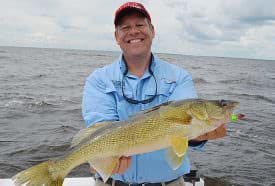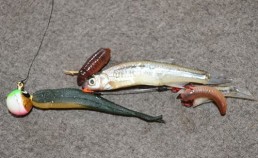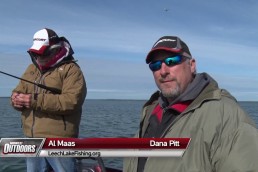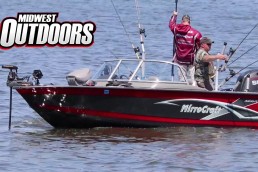Increasing Jigging Odds on the ‘Walleye Capital’
SHARE THIS POST
When I first heard the fishing report from a “local” at Lake of the Woods, I could hardly believe it. Initially, it did not make sense to me. The charter boats were pulling in limits of fish—nothing new; the anglers were using jigs and frozen shiners—that makes sense so far. But what really surprised me was the “way” they were catching fish. They were not drifting, but were anchored up in “no man’s land,” and jigging.
I had to think about it and ask a few questions, because it seemed foreign to me the boats were not drifting to cover more water and get over more fish, especially over big open mud flats of Big Traverse Bay. At 15 miles wide, this is big water with no structure. Why would someone want to anchor up?
Because, that’s the way the walleyes want it.
Why do they want it this way? Nobody knows, but do we know this technique for extracting walleyes and saugers from here is deadly. I’ve watched many drift by with little success, while boats all around and anchored up are hammering the fish. It is easy, effective fishing, and there are some nuances for helping catch more fish.
Fishing equipment
A spinning reel with a medium-action rod is the go-to setup. I prefer jigging a superline with no stretch. Take your pick; FireLine, Suffix 832 or Power Pro lines are all good. The no-stretch allows me to feel everything going on in 30 feet of water. Tie it directly to the jig. In the stained waters of Lake of the Woods, it doesn’t seem to matter to the fish. With very light bites at times, sensitivity is huge, and you will catch more by feeling everything that is going on.
The jigs
There are many quality jigs on the market. Rather than focus on brand, let’s discuss size. My entire life, I have heard the mention, “Use as light of a jig as the conditions allow.” In some cases, I agree. But from experience and the many discussions with experienced charter captains on the lake, I prefer a heavier jig, at 1/4 to 1/2 ounce. The heavier jig is a larger profile for the fish to see in murky water. When I allow the jig to pound the mud bottom, it really creates some disturbance, which to a walleye, is often a meal. It is also easier to maintain control with the jig relating to the bottom in deeper water, windy conditions, etc. And the bottom line is: the fish hammer them.
Color
With the stained water here, gold is a staple. I also like to mix it up with gold and another color, like glow-white or pink. Some days, chartreuse, orange or bubble gum will outfish everything. Start out with different colors and use what works.
The bait
Frozen shiners are the go-to minnow. Not only are they a staple food of the walleyes and saugers, but they also give off a ton of scent and have shiny scales that fall off and float around when the bait is jigged. Other minnows, such as fatheads, rainbows, and chubs work, but there is something special about frozen shiners.
In the summer, ‘crawlers and leeches work tool. When fishing tournaments, I use a gold, glow and pink jig with a stinger hook. On the jig, I slide on a plastic and place the stinger hook over the jig hook and add a shiner and a piece of nightcrawler.
On the stinger hook, I add a small piece of ‘crawler and one-half a frozen shiner. It’s called the “Full Meal Deal,” but what I do know is that it works.
The Gulp Alive was a twist I added. When I would get a bite, set the hook and miss the fish, it was game over. My bait would disintegrate, and by the time I reeled up to rebait, the fish was gone. With the Gulp on the jig, the fish is still hot and it is game on, as I still am baited.
Are you enjoying this post?
You can be among the first to get the latest info on where to go, what to use and how to use it!
A friend who is a great angler will hook a leech on the jig followed by a frozen shiner. The thought is the leech gives constant action and good scent with the irresistible frozen shiner on top.
Nuances to hooking a frozen shiner
Hooking a frozen shiner and keeping it on your hook can be a challenge, as they’re mushy. It is tough to hook the frozen shiner through the head as it just kind of disintegrates and comes off a jig. Place the hook of the jig through both eyes of the frozen shiner and then slide the minnow up on the jig. Hook it again through the mid-section; the bait will be on its side, but the fish do not care. Also, the hook is positioned halfway back on the minnow, which leads to a higher hooking percentage.
Others will put the hook through the mouth of the minnow and out the gill, then thread the minnow as far up on the jig as it will go and hook the minnow in the side with the hook coming out its back. The minnow stays on well, and you will hook more fish, as the hook is farther back on the minnow.
Another way to rig a frozen shiner is by pinching off the head and hooking the jig through the strong mid-section of the minnow. There is good scent, good flash and the minnow stays on well. Some anglers have discovered using two minnows on a jig increases their catch rate too. Perhaps it’s the smell factor and a larger profile.
Jigging techniques
As every day can be different, there is one technique that is proven. For some reason, many fish like a subtle presentation. Pounding the bottom with the jig and lifting it into the strike zone and holding it still catches fish—and at 6 inches to 1 foot off the bottom is a good bet.
Sometimes, I will intentionally lift my rod tip up very slowly and do it often for “feeling” those light-biters just hanging on like a wet sock, but don’t tap it. When you get used to how the jig and minnow feels, it will feel like there is just a bit too much weight when you lift up. This is when to set the hook. You really never know if it is just an eater fish or one of the big trophies.
Another technique is tapping the butt of my rod and allowing the vibration to travel down the superline to the jig. That vibration and quivering action can be deadly.
Positioning the boat
When fishing the mud in no man’s land, try and get a consensus of what depth to begin. Following the weekly fishing reports from Lake of the Woods Tourism or your favorite resort will get you close. Watch your electronics for bait or fish, and set the anchor. At times the walleyes are lying so tight to the mud bottom they don’t show up on most sonar. Because of that, I have set the anchor even though I did not mark any fish. Typically, give it 30 minutes in a spot. If you start catching great, if not, reposition.
The Lake of the Woods’ style of jigging works on the reefs. Use your electronics to position your boat. Sometimes the walleyes will be on top, especially if there is wind action or when the crawfish are there. Other times, the fish might be hanging in the mud just off the edge of the reef. Every day can be different, but just go and figure them out.
I have to admit; vertical jigging here is an absolute blast. Once anchored up and not having to worry about boat control, working structure, speed, etc., is a nice option from the norm. There’s nothing more enjoyable than feeling the bite with a rod in hand, setting the hook and watching that rod bend. With every hook-set, the fish on the other end could be one of the thousands of small walleyes the lake has produced, or it could be that 12-pound trophy of a lifetime.
MWO
SHARE THIS POST
Did you enjoy this post?
You can be among the first to get the latest info on where to go, what to use and how to use it!
Joe Henry
Tournament angler and licensed charter captain Joe Henry fishes and hunts the Midwest. Henry is a media member of AGLOW and writes for numerous publications, creates videos, appears on a variety of outdoor TV and radio shows and is a frequent seminar speaker. Henry is the Executive Director of Lake of the Woods Tourism.



